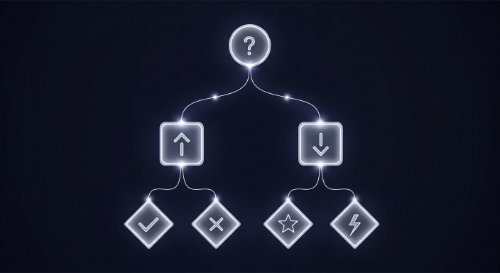General Mathematics
Learning Track Courses
 Number Base Systems - Mathematics (Senior Secondary)This course provides a complete study of number base systems, a core concept in mathematics and computer science. It moves beyond the familiar base 10 system to explore how numbers are represented and manipulated in other bases, such as binary, which forms the foundation of all digital technology. We will cover the principles of different bases, methods for conversion between them, and arithmetic operations within these systems.
A command of number bases is non-negotiable for anyone serious about computer science or digital electronics. It is the language of computers. This knowledge is essential for understanding data representation, low-level programming, and network protocols. It provides a deeper appreciation for the structure of the number system we use every day.
By the end of this course, you will be able to convert any number from one base to another, including decimal fractions. You will perform addition, subtraction, multiplication, and division in any base with confidence. You will also explain the direct application of the binary system in computer programming.
This course is built for secondary school students taking their first formal steps into advanced mathematical concepts. It is also essential for aspiring programmers, computer science students, and electronics enthusiasts who need to understand the fundamental principles of digital systems. No prior knowledge beyond basic arithmetic is required.
Number Base Systems - Mathematics (Senior Secondary)This course provides a complete study of number base systems, a core concept in mathematics and computer science. It moves beyond the familiar base 10 system to explore how numbers are represented and manipulated in other bases, such as binary, which forms the foundation of all digital technology. We will cover the principles of different bases, methods for conversion between them, and arithmetic operations within these systems.
A command of number bases is non-negotiable for anyone serious about computer science or digital electronics. It is the language of computers. This knowledge is essential for understanding data representation, low-level programming, and network protocols. It provides a deeper appreciation for the structure of the number system we use every day.
By the end of this course, you will be able to convert any number from one base to another, including decimal fractions. You will perform addition, subtraction, multiplication, and division in any base with confidence. You will also explain the direct application of the binary system in computer programming.
This course is built for secondary school students taking their first formal steps into advanced mathematical concepts. It is also essential for aspiring programmers, computer science students, and electronics enthusiasts who need to understand the fundamental principles of digital systems. No prior knowledge beyond basic arithmetic is required.
This course provides a complete study of number base systems, a core concept in mathematics and computer science. It moves beyond the familiar base 10 system to explore how numbers are represented and manipulated in other bases, such as binary, which forms the foundation of all digital technology. We will cover the principles of different bases, methods for conversion between them, and arithmetic operations within these systems. A command of number bases is non-negotiable for anyone serious about computer science or digital electronics. It is the language of computers. This knowledge is essential for understanding data representation, low-level programming, and network protocols. It provides a deeper appreciation for the structure of the number system we use every day. By the end of this course, you will be able to convert any number from one base to another, including decimal fractions. You will perform addition, subtraction, multiplication, and division in any base with confidence. You will also explain the direct application of the binary system in computer programming. This course is built for secondary school students taking their first formal steps into advanced mathematical concepts. It is also essential for aspiring programmers, computer science students, and electronics enthusiasts who need to understand the fundamental principles of digital systems. No prior knowledge beyond basic arithmetic is required.
 Modular Arithmetic - Mathematics (Senior Secondary)This course provides a practical introduction to modular arithmetic, a system of arithmetic for integers where numbers "wrap around" upon reaching a certain value - the modulus. Often called "clock arithmetic," this topic moves beyond linear calculations to explore cyclical operations. We will establish the core concepts and then apply them to solve practical problems.
An understanding of modular arithmetic is essential for fields that rely on cyclical patterns and integer operations, including cryptography, computer science, and number theory. It provides a powerful tool for simplifying problems involving remainders and is a required concept for understanding modern data encryption standards.
By the end of this course, you will be able to define modular arithmetic and perform calculations within a given modulus. You will solve problems involving congruences and apply these concepts to practical, real-world scenarios like telling time and determining days of the week.
This course is designed for secondary school students being introduced to abstract mathematical systems. It is also valuable for anyone with an interest in cryptography or computer science who wants to understand the foundational arithmetic behind key algorithms. Basic arithmetic skill is the only prerequisite.
Modular Arithmetic - Mathematics (Senior Secondary)This course provides a practical introduction to modular arithmetic, a system of arithmetic for integers where numbers "wrap around" upon reaching a certain value - the modulus. Often called "clock arithmetic," this topic moves beyond linear calculations to explore cyclical operations. We will establish the core concepts and then apply them to solve practical problems.
An understanding of modular arithmetic is essential for fields that rely on cyclical patterns and integer operations, including cryptography, computer science, and number theory. It provides a powerful tool for simplifying problems involving remainders and is a required concept for understanding modern data encryption standards.
By the end of this course, you will be able to define modular arithmetic and perform calculations within a given modulus. You will solve problems involving congruences and apply these concepts to practical, real-world scenarios like telling time and determining days of the week.
This course is designed for secondary school students being introduced to abstract mathematical systems. It is also valuable for anyone with an interest in cryptography or computer science who wants to understand the foundational arithmetic behind key algorithms. Basic arithmetic skill is the only prerequisite.
This course provides a practical introduction to modular arithmetic, a system of arithmetic for integers where numbers "wrap around" upon reaching a certain value - the modulus. Often called "clock arithmetic," this topic moves beyond linear calculations to explore cyclical operations. We will establish the core concepts and then apply them to solve practical problems. An understanding of modular arithmetic is essential for fields that rely on cyclical patterns and integer operations, including cryptography, computer science, and number theory. It provides a powerful tool for simplifying problems involving remainders and is a required concept for understanding modern data encryption standards. By the end of this course, you will be able to define modular arithmetic and perform calculations within a given modulus. You will solve problems involving congruences and apply these concepts to practical, real-world scenarios like telling time and determining days of the week. This course is designed for secondary school students being introduced to abstract mathematical systems. It is also valuable for anyone with an interest in cryptography or computer science who wants to understand the foundational arithmetic behind key algorithms. Basic arithmetic skill is the only prerequisite.
 Introduction to Set Theory - Mathematics (Senior Secondary)This course introduces the fundamental principles of set theory, the branch of mathematics dedicated to the study of collections of objects. We will explore how to precisely define, describe, and denote sets. The course covers the different types of sets, including universal sets, empty sets, subsets, and power sets, providing the formal language used across all of modern mathematics.
A command of set theory is non-negotiable for any serious student of mathematics, computer science, or statistics. It is the foundational language used to construct more complex ideas in logic, probability, and database theory. Understanding how to group and operate on collections of data is a critical skill for creating algorithms, analysing information, and building valid logical arguments.
By the end of this course, you will be able to correctly use set notation to define any given set. You will identify different types of sets and their relationships, perform core set operations such as union, intersection, and complement, and use Venn diagrams to visually solve complex problems involving up to three sets.
This course is built for secondary school students taking their first steps into abstract mathematical reasoning. It is an essential prerequisite for anyone planning to study computer science, data analysis, or any field that requires rigorous logical and structural thinking. No prior knowledge is required.
Introduction to Set Theory - Mathematics (Senior Secondary)This course introduces the fundamental principles of set theory, the branch of mathematics dedicated to the study of collections of objects. We will explore how to precisely define, describe, and denote sets. The course covers the different types of sets, including universal sets, empty sets, subsets, and power sets, providing the formal language used across all of modern mathematics.
A command of set theory is non-negotiable for any serious student of mathematics, computer science, or statistics. It is the foundational language used to construct more complex ideas in logic, probability, and database theory. Understanding how to group and operate on collections of data is a critical skill for creating algorithms, analysing information, and building valid logical arguments.
By the end of this course, you will be able to correctly use set notation to define any given set. You will identify different types of sets and their relationships, perform core set operations such as union, intersection, and complement, and use Venn diagrams to visually solve complex problems involving up to three sets.
This course is built for secondary school students taking their first steps into abstract mathematical reasoning. It is an essential prerequisite for anyone planning to study computer science, data analysis, or any field that requires rigorous logical and structural thinking. No prior knowledge is required.
This course introduces the fundamental principles of set theory, the branch of mathematics dedicated to the study of collections of objects. We will explore how to precisely define, describe, and denote sets. The course covers the different types of sets, including universal sets, empty sets, subsets, and power sets, providing the formal language used across all of modern mathematics. A command of set theory is non-negotiable for any serious student of mathematics, computer science, or statistics. It is the foundational language used to construct more complex ideas in logic, probability, and database theory. Understanding how to group and operate on collections of data is a critical skill for creating algorithms, analysing information, and building valid logical arguments. By the end of this course, you will be able to correctly use set notation to define any given set. You will identify different types of sets and their relationships, perform core set operations such as union, intersection, and complement, and use Venn diagrams to visually solve complex problems involving up to three sets. This course is built for secondary school students taking their first steps into abstract mathematical reasoning. It is an essential prerequisite for anyone planning to study computer science, data analysis, or any field that requires rigorous logical and structural thinking. No prior knowledge is required.
 Indices and Logarithms - Mathematics (Senior Secondary)This course provides a comprehensive guide to indices and their inverse, logarithms. It treats them not as separate topics, but as two sides of the same coin. The course begins with a mastery of the laws of indices before using that knowledge to define and derive the principles of logarithms, which are essential tools for simplifying complex calculations.
A command of indices and logarithms is non-negotiable for success in any advanced science, technology, engineering, or mathematics (STEM) field. These concepts are fundamental to modelling exponential growth and decay, analysing data on logarithmic scales (like pH or decibels), and solving advanced equations in calculus and physics.
By the end of this course, you will be able to confidently apply the laws of indices to simplify expressions and solve equations. You will understand the definition of a logarithm, read logarithm and antilogarithm tables, and use them to perform complex calculations involving multiplication, division, powers, and roots.
This course is built for students preparing for higher-level mathematics. It is also essential for anyone entering scientific or financial fields who needs a strong command of these foundational calculation tools. A solid understanding of basic algebra is required.
Indices and Logarithms - Mathematics (Senior Secondary)This course provides a comprehensive guide to indices and their inverse, logarithms. It treats them not as separate topics, but as two sides of the same coin. The course begins with a mastery of the laws of indices before using that knowledge to define and derive the principles of logarithms, which are essential tools for simplifying complex calculations.
A command of indices and logarithms is non-negotiable for success in any advanced science, technology, engineering, or mathematics (STEM) field. These concepts are fundamental to modelling exponential growth and decay, analysing data on logarithmic scales (like pH or decibels), and solving advanced equations in calculus and physics.
By the end of this course, you will be able to confidently apply the laws of indices to simplify expressions and solve equations. You will understand the definition of a logarithm, read logarithm and antilogarithm tables, and use them to perform complex calculations involving multiplication, division, powers, and roots.
This course is built for students preparing for higher-level mathematics. It is also essential for anyone entering scientific or financial fields who needs a strong command of these foundational calculation tools. A solid understanding of basic algebra is required.
This course provides a comprehensive guide to indices and their inverse, logarithms. It treats them not as separate topics, but as two sides of the same coin. The course begins with a mastery of the laws of indices before using that knowledge to define and derive the principles of logarithms, which are essential tools for simplifying complex calculations. A command of indices and logarithms is non-negotiable for success in any advanced science, technology, engineering, or mathematics (STEM) field. These concepts are fundamental to modelling exponential growth and decay, analysing data on logarithmic scales (like pH or decibels), and solving advanced equations in calculus and physics. By the end of this course, you will be able to confidently apply the laws of indices to simplify expressions and solve equations. You will understand the definition of a logarithm, read logarithm and antilogarithm tables, and use them to perform complex calculations involving multiplication, division, powers, and roots. This course is built for students preparing for higher-level mathematics. It is also essential for anyone entering scientific or financial fields who needs a strong command of these foundational calculation tools. A solid understanding of basic algebra is required.
 Simple Equations and Variations - Mathematics (Senior Secondary)This course builds essential algebraic skills required for all scientific and technical fields. It is divided into two parts: the manipulation of equations and the study of variation. You will first learn to confidently rearrange and solve formulae, then master the principles of direct, inverse, joint, and partial variation to model relationships between quantities.
The ability to manipulate equations and understand variation is fundamental to problem-solving in science and engineering. These skills are not abstract - they are the tools used to model physical laws, analyse data, and create predictive financial models. Proficiency here is a direct prerequisite for physics, chemistry, economics, and higher mathematics.
By the end of of this course, you will be able to change the subject of any formula, regardless of its complexity. You will also be able to identify the type of variation in a given problem, formulate an equation to model it, and use that equation to find unknown values.
This course is designed for students building their core algebraic foundation. It is essential for anyone planning to study science, engineering, or economics at a higher level. A basic understanding of linear equations is assumed.
Simple Equations and Variations - Mathematics (Senior Secondary)This course builds essential algebraic skills required for all scientific and technical fields. It is divided into two parts: the manipulation of equations and the study of variation. You will first learn to confidently rearrange and solve formulae, then master the principles of direct, inverse, joint, and partial variation to model relationships between quantities.
The ability to manipulate equations and understand variation is fundamental to problem-solving in science and engineering. These skills are not abstract - they are the tools used to model physical laws, analyse data, and create predictive financial models. Proficiency here is a direct prerequisite for physics, chemistry, economics, and higher mathematics.
By the end of of this course, you will be able to change the subject of any formula, regardless of its complexity. You will also be able to identify the type of variation in a given problem, formulate an equation to model it, and use that equation to find unknown values.
This course is designed for students building their core algebraic foundation. It is essential for anyone planning to study science, engineering, or economics at a higher level. A basic understanding of linear equations is assumed.
This course builds essential algebraic skills required for all scientific and technical fields. It is divided into two parts: the manipulation of equations and the study of variation. You will first learn to confidently rearrange and solve formulae, then master the principles of direct, inverse, joint, and partial variation to model relationships between quantities. The ability to manipulate equations and understand variation is fundamental to problem-solving in science and engineering. These skills are not abstract - they are the tools used to model physical laws, analyse data, and create predictive financial models. Proficiency here is a direct prerequisite for physics, chemistry, economics, and higher mathematics. By the end of of this course, you will be able to change the subject of any formula, regardless of its complexity. You will also be able to identify the type of variation in a given problem, formulate an equation to model it, and use that equation to find unknown values. This course is designed for students building their core algebraic foundation. It is essential for anyone planning to study science, engineering, or economics at a higher level. A basic understanding of linear equations is assumed.
 Introduction to Quadratic Equations - Mathematics (Senior Secondary)This course provides a focused introduction to quadratic equations, a cornerstone of algebra. We will move beyond linear equations to explore expressions with a squared term, covering the essential skills needed for the first term curriculum. The course focuses on the factorisation method for solving quadratics and the process of forming equations from their roots.
Quadratic equations are essential tools in a vast range of fields. They are used in physics to model projectile motion, in engineering to design parabolic structures like satellite dishes, and in finance to optimise profit. Mastering these introductory concepts is a non-negotiable step for anyone advancing in mathematics or the physical sciences.
By the end of this course, you will be able to factorise any simple quadratic expression and use this method to find the roots of an equation. You will also learn to construct a quadratic equation if you are given its roots, providing a solid foundation before moving on to more advanced methods in later terms.
This course is designed for students who have a solid foundation in linear equations and algebraic factorisation. It is a critical course for all students on the science track and serves as the gateway to the study of more complex polynomials and functions.
Introduction to Quadratic Equations - Mathematics (Senior Secondary)This course provides a focused introduction to quadratic equations, a cornerstone of algebra. We will move beyond linear equations to explore expressions with a squared term, covering the essential skills needed for the first term curriculum. The course focuses on the factorisation method for solving quadratics and the process of forming equations from their roots.
Quadratic equations are essential tools in a vast range of fields. They are used in physics to model projectile motion, in engineering to design parabolic structures like satellite dishes, and in finance to optimise profit. Mastering these introductory concepts is a non-negotiable step for anyone advancing in mathematics or the physical sciences.
By the end of this course, you will be able to factorise any simple quadratic expression and use this method to find the roots of an equation. You will also learn to construct a quadratic equation if you are given its roots, providing a solid foundation before moving on to more advanced methods in later terms.
This course is designed for students who have a solid foundation in linear equations and algebraic factorisation. It is a critical course for all students on the science track and serves as the gateway to the study of more complex polynomials and functions.
This course provides a focused introduction to quadratic equations, a cornerstone of algebra. We will move beyond linear equations to explore expressions with a squared term, covering the essential skills needed for the first term curriculum. The course focuses on the factorisation method for solving quadratics and the process of forming equations from their roots. Quadratic equations are essential tools in a vast range of fields. They are used in physics to model projectile motion, in engineering to design parabolic structures like satellite dishes, and in finance to optimise profit. Mastering these introductory concepts is a non-negotiable step for anyone advancing in mathematics or the physical sciences. By the end of this course, you will be able to factorise any simple quadratic expression and use this method to find the roots of an equation. You will also learn to construct a quadratic equation if you are given its roots, providing a solid foundation before moving on to more advanced methods in later terms. This course is designed for students who have a solid foundation in linear equations and algebraic factorisation. It is a critical course for all students on the science track and serves as the gateway to the study of more complex polynomials and functions.
 Introduction to Logical Reasoning - Mathematics (Senior Secondary)This course provides a formal introduction to the principles of mathematical logic. It moves beyond simple calculation to focus on the structure and validity of mathematical statements. You will learn to identify and analyse simple and compound statements, understand the concept of truth values, and use symbolic logic to represent arguments.
Logical reasoning is the bedrock of mathematics and computer science. While other topics teach you how to calculate, this subject teaches you how to think and construct valid arguments. This skill is non-negotiable for writing proofs, developing algorithms, and designing complex systems where precision and the absence of ambiguity are critical.
By the end of this course, you will be able to define a mathematical statement and determine its truth value. You will understand and use logical operators such as conjunction and conditional statements. You will also be able to translate simple verbal arguments into symbolic logic.
This course is designed for students who are beginning to engage with more abstract mathematical concepts. It is essential for anyone intending to study higher mathematics, computer science, or philosophy. No prior knowledge is required beyond a clear thought process.
Introduction to Logical Reasoning - Mathematics (Senior Secondary)This course provides a formal introduction to the principles of mathematical logic. It moves beyond simple calculation to focus on the structure and validity of mathematical statements. You will learn to identify and analyse simple and compound statements, understand the concept of truth values, and use symbolic logic to represent arguments.
Logical reasoning is the bedrock of mathematics and computer science. While other topics teach you how to calculate, this subject teaches you how to think and construct valid arguments. This skill is non-negotiable for writing proofs, developing algorithms, and designing complex systems where precision and the absence of ambiguity are critical.
By the end of this course, you will be able to define a mathematical statement and determine its truth value. You will understand and use logical operators such as conjunction and conditional statements. You will also be able to translate simple verbal arguments into symbolic logic.
This course is designed for students who are beginning to engage with more abstract mathematical concepts. It is essential for anyone intending to study higher mathematics, computer science, or philosophy. No prior knowledge is required beyond a clear thought process.
This course provides a formal introduction to the principles of mathematical logic. It moves beyond simple calculation to focus on the structure and validity of mathematical statements. You will learn to identify and analyse simple and compound statements, understand the concept of truth values, and use symbolic logic to represent arguments. Logical reasoning is the bedrock of mathematics and computer science. While other topics teach you how to calculate, this subject teaches you how to think and construct valid arguments. This skill is non-negotiable for writing proofs, developing algorithms, and designing complex systems where precision and the absence of ambiguity are critical. By the end of this course, you will be able to define a mathematical statement and determine its truth value. You will understand and use logical operators such as conjunction and conditional statements. You will also be able to translate simple verbal arguments into symbolic logic. This course is designed for students who are beginning to engage with more abstract mathematical concepts. It is essential for anyone intending to study higher mathematics, computer science, or philosophy. No prior knowledge is required beyond a clear thought process.